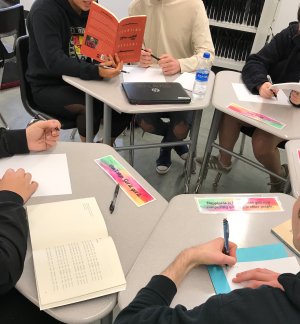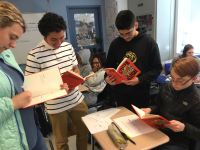How Living Poets Can Inspire Students
A classroom activity for sharing the work of living poets shows students that poetry isn’t a thing of the past.
Your content has been saved!
Go to My Saved Content.When I announced our poetry unit to my high school freshmen, I was met with loud sighs and groans. While I was disheartened by the reaction, I was not surprised. I remember feeling similarly about poetry when I was their age. Poetry was difficult, boring, coded, dated, and not relatable. When I look at the literary canon—Walt Whitman, Robert Frost, Edgar Allan Poe, and others—that reaction makes sense. The poets that students are so often exposed to are overwhelmingly male, white, straight, and, well, dead.
We shouldn’t necessarily stop teaching these poets, but we also shouldn’t let this canon limit how we define poetry, nor should we automatically make these poets the default.
Teaching ninth grade English language arts at a public high school in Los Angeles, I was looking for ways to better help students connect and engage with the magic of poetry. I was thrilled to find a movement on Twitter called #TeachLivingPoets and was inspired by it. I was excited to demonstrate to my students that poetry does not exist solely as an artifact of the past—it’s happening now.
By teaching living poets, we not only provide more modern and relatable content for students to analyze, discuss, and write about, but also remind them that they too are poets. When students read relatable poetry, it helps them view themselves as creative artists as well.
When I began this poetry unit, my first goal was for each student to find just one poem that they connected with and loved—no easy feat. I had several students who were particularly resistant to the idea of poetry. So I decided on a few introductory activities, starting with poetry blind dating, to promote student discovery and student choice in this process.
Poetry Blind Dating
Inspired by one of the many resources and posts on the Teach Living Poets website, I decorated my room with flowers and (fake) candles and put on some romantic music. Around the room, I had eight stations, each with multiple copies of a poem by a living poet. The copies were folded so students could not initially see the poems. On each desk, I put a list of keywords from the poem. I told students to walk around the room and look for any keywords that jumped out at them. If they found keywords that intrigued them, they were invited to go on a “date” with that poem by reading it quietly to themselves. I asked them to go on at least three “dates.”

Afterward, they picked one poem they wanted to explore further. After choosing, they did research on the poet and answered some analytical questions to delve deeper in their critical thinking. A few things they explored:
- The SOAPSTone technique for reading
- The poem’s central theme
- A meaningful line or verse
This playful activity allowed students to engage in kinesthetic learning, and gave them the power to choose which poem they wanted to explore more deeply, while also exposing them to several different poets and style of poetry. I asked students to write down some of their reactions to the activity. Here are some of the responses:
- “I have always disliked [poetry], I thought it was corny and boring. Now it is one of my favorite things to do in English.”
- “I’ve always loved poetry, but these past few weeks really invigorated my passion for it.”
- “I found out that poetry is kind of fun.” (This is from one of my most resistant students.)
Before I started the poetry unit, my students created a word cloud of terms that came to mind when they thought of poetry. The most common words: rhyme, difficult, bad, dumb. After the poetry unit, they shared such words as powerful, beauty, fun, art.
Living Poets Who Inspire
While there are many moving and talented living poets out there, here are a handful who have performed particularly well with my students, with the titles of one of their collections:
- Clint Smith: Counting Descent
- Sarah Kay: No Matter the Wreckage
- José Olivarez: Citizen Illegal
- Rupi Kaur: milk and honey
- Eve L. Ewing: Electric Arches
- Hanif Abdurraqib: The Crown Ain’t Worth Much
- Fatimah Asghar: If They Come for Us
If your students are still not connecting with poetry, challenge them to research other living poets. Allow them the freedom to take charge of their own learning and explore poetry on their own—not just who and what you have provided for them. Let them step inside the ever-expanding world of poetry and share poems they find (or write!) with others in the class.
Why Poetry Matters
When we teach poetry, we really must stop and reflect on the purposes of these lessons. Why poetry? Why teach, read, or write poetry at all? Poetry connects us in ways that many other types of texts do not. It moves us. It expands our worldview. It challenges societal norms and expectations. And it reminds us that we are not alone. That words are beautiful, and powerful, and meaningful. And this beauty, power, and meaning are not limited to the past.
Poetry is living. It is breathing. It is happening all around us. All we need to do as educators is open that door for students, and bring our classrooms alive with living poets.
